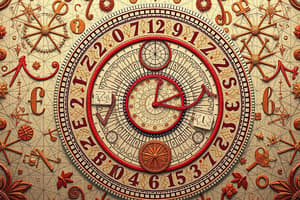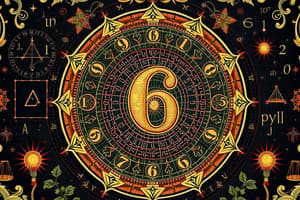Podcast
Questions and Answers
Which of the following sets includes all natural numbers?
Which of the following sets includes all natural numbers?
- 1/2, 2/3, 3/4, ...
- -1, 0, 1, 2, 3, ...
- 1, 2, 3, ... (correct)
- 0, 1, 2, 3, ...
What is the term for the total distance around a triangle?
What is the term for the total distance around a triangle?
- Perimeter (correct)
- Diameter
- Area
- Circumference
In the equation $2x + 3 = 7$, what is the value of x?
In the equation $2x + 3 = 7$, what is the value of x?
- 2
- 4
- 3
- 1 (correct)
What type of angle has a measure less than 90 degrees?
What type of angle has a measure less than 90 degrees?
Which of the following best describes a rational number?
Which of the following best describes a rational number?
Flashcards are hidden until you start studying
Study Notes
Key Concepts in Math
1. Number Systems
- Natural Numbers: Counting numbers (1, 2, 3,…)
- Whole Numbers: Natural numbers including zero (0, 1, 2, 3,…)
- Integers: Whole numbers and their negatives (…,-3, -2, -1, 0, 1, 2, 3,…)
- Rational Numbers: Numbers that can be expressed as fractions (a/b, where b ≠ 0)
- Irrational Numbers: Numbers that cannot be expressed as fractions (π, √2)
- Real Numbers: All rational and irrational numbers
2. Basic Operations
- Addition (+): Combining quantities
- Subtraction (−): Finding the difference between quantities
- Multiplication (×): Repeated addition
- Division (÷): Distributing a quantity into equal parts
3. Algebra
- Variables: Symbols (usually letters) representing unknown values
- Expressions: Combinations of variables and constants (e.g., 3x + 2)
- Equations: Statements asserting the equality of two expressions (e.g., 2x + 3 = 7)
- Functions: Relations between inputs and outputs, often represented as f(x)
4. Geometry
- Shapes: Basic figures like circles, triangles, rectangles, and polygons
- Angles: Measured in degrees; types include acute, obtuse, right, and straight
- Perimeter: The total distance around a shape
- Area: The measure of the space inside a shape (e.g., A = l × w for rectangles)
- Volume: The measure of space in three dimensions (e.g., V = l × w × h for cubes)
5. Trigonometry
- Sine, Cosine, Tangent: Ratios of sides of a right triangle
- Pythagorean Theorem: a² + b² = c² (relationship between the sides of a right triangle)
- Unit Circle: Circle with radius 1 used to define trigonometric functions
6. Calculus
- Limits: The value a function approaches as the input approaches a point
- Derivatives: Measure of how a function changes as its input changes; slope of a curve
- Integrals: Represent the accumulation of quantities; area under a curve
7. Statistics
- Mean: Average of a set of numbers
- Median: Middle value in a sorted list
- Mode: Most frequently occurring value
- Standard Deviation: Measure of data dispersion
8. Probability
- Event: A single outcome or a combination of outcomes
- Probability Formula: P(E) = Number of favorable outcomes / Total number of outcomes
- Independent Events: Events whose outcomes do not affect one another
9. Mathematical Reasoning
- Logical Thinking: Using reasoning to arrive at conclusions
- Proof Techniques: Include direct proof, contradiction, and induction
Study Tips
- Practice problems regularly to reinforce concepts.
- Use visual aids (e.g., graphs, charts) for understanding complex topics.
- Summarize each concept in your own words to enhance retention.
Number Systems
- Natural numbers are used for counting (1, 2, 3, ...)
- Whole numbers include zero (0, 1, 2, 3, ...)
- Integers include negative numbers (..., -3, -2, -1, 0, 1, 2, 3, ...)
- Rational numbers can be expressed as fractions (a/b, where b ≠ 0)
- Irrational numbers cannot be expressed as fractions (like π and √2)
- Real numbers encompass both rational and irrational numbers
Basic Operations
- Addition combines quantities
- Subtraction finds the difference between two quantities
- Multiplication is repeated addition
- Division distributes a quantity into equal parts
Algebra
- Variables are symbols (often letters) representing unknown values
- Expressions combine variables and constants (e.g., 3x + 2)
- Equations are used to express the equality of two expressions (e.g., 2x + 3 = 7)
- Functions show the relationship between inputs and outputs, often represented as f(x)
Geometry
- Shapes are basic figures such as circles, triangles, rectangles, and polygons
- Angles are measured in degrees, with types like acute, obtuse, right, and straight
- Perimeter is the total distance around a shape
- Area measures the space inside a shape (e.g., for a rectangle, A = l × w)
- Volume measures the space in three dimensions (e.g., for a cube, V = l × w × h)
Trigonometry
- Sine, cosine, and tangent are ratios of sides in a right triangle
- The Pythagorean Theorem (a² + b² = c²) relates the sides of a right triangle
- The unit circle (radius 1) helps define trigonometric functions
Calculus
- Limits describe the value a function approaches as its input approaches a point
- Derivatives measure how a function changes as its input changes (slope of the curve)
- Integrals represent the accumulation of quantities (area under a curve)
Statistics
- Mean calculates the average of a set of numbers
- Median is the middle value in a sorted list
- Mode is the most frequently occurring value
- Standard deviation measures data dispersion
Probability
- Events are single outcomes or combinations of outcomes
- The probability of an event is calculated as: P(E) = Number of favorable outcomes / Total number of outcomes
- Independent events are those whose outcomes do not affect each other
Mathematical Reasoning
- Logical thinking involves applying reasoning to arrive at conclusions
- Proof techniques include direct proof, contradiction, and induction
Studying That Suits You
Use AI to generate personalized quizzes and flashcards to suit your learning preferences.




